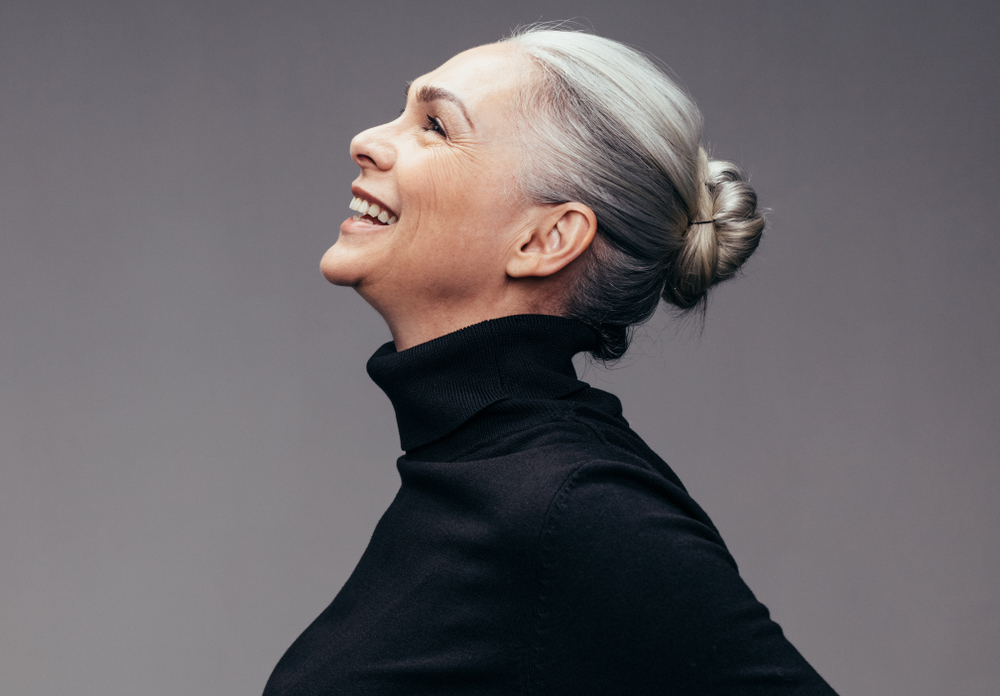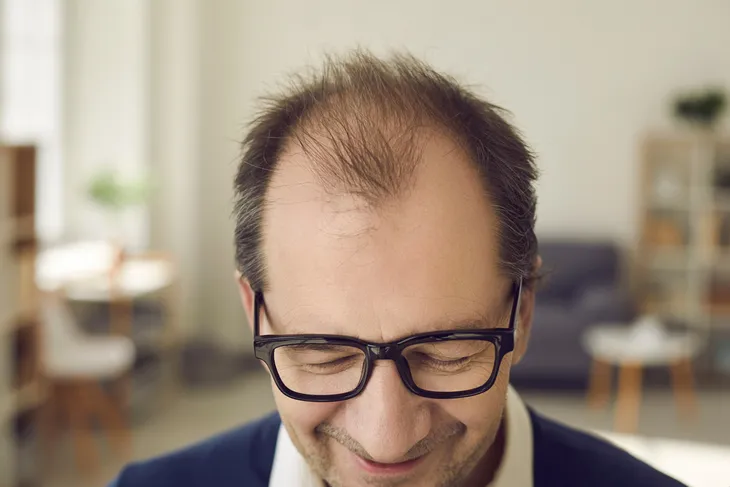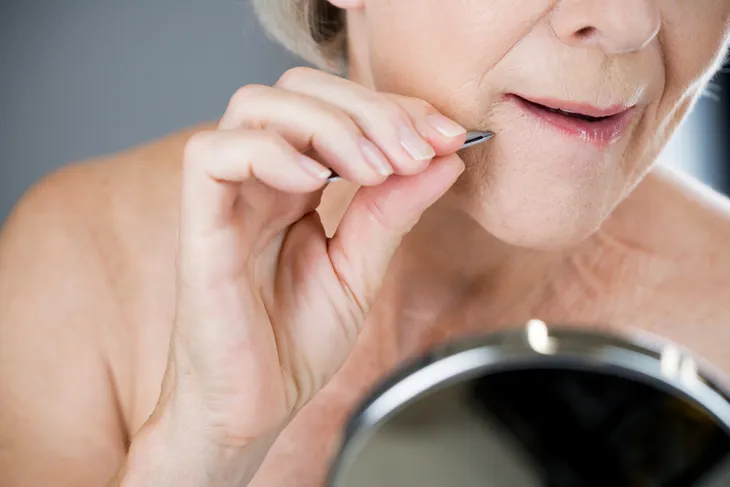- It’s normal to experience many changes as you age, including changes to your hair.
- Your hair may grow gray, become thinner, or change in texture.
- Some people embrace their changes while others find it distressing. Luckily there are ways to manage it!
Aging brings on a lot of changes. You may notice more aches and pains, your weight may fluctuate, and you might even get shorter! Another notable change that occurs with aging is our hair.
It’s common for hair to change in color, texture, and thickness as we age. While it may not bother some, it can be distressing for others. Not to mention, learning how to manage new hair changes can be overwhelming and quite the learning curve. Luckily there are simple ways to manage it! Follow along as we find out how hair changes as we age plus tips to help you manage it.
Changes in Hair Color
One of the telltale signs of aging is graying hair. It typically starts around age 30- to 40-years but it can be much earlier for some people. Though many people dread going gray, it is a very natural process.
The Cleveland Clinic says that the reason your hair turns gray is all due to melanin. Melanin is a pigment that tints not only your hair but your eyes and skin too. As you age, melanin begins to decrease resulting in graying hair. When the hair is completely white this means there is no melanin left. It’s also worth noting that body and facial hair can turn gray too but it usually happens later than the hair on your head.
How to Manage Graying Hair
According to the National Library of Medicine, graying hair is greatly determined by your genes. This means that supplements and other products won’t stop or decrease the rate of graying. So, one option is to embrace your graying hair. It’s a natural part of life and you don’t have to hide it. That said, some people aren’t ready to fully embrace it and that’s okay too. Luckily you have options!
Permanent and demi-permanent hair dyes and temporary tints are available if you’re not ready to let your hair go gray. You can also consider slowly transitioning by mixing your naturally gray hair with highlights. Book an appointment with your stylist to discuss the best options for you.
Changes to Hair Thickness
Is your hair gradually getting thinner as you grow older? You’re not alone! This is yet another common change to expect with aging. The National Library of Medicine says that nearly everyone has some hair loss with aging.
The Source says that your hair strands become smaller and have less pigment which contributes to overall thinness. Additionally, “many hair follicles stop producing new hairs.” Your hair may even grow so thin that you eventually become bald. And baldness can happen to both men and women.
What to Know About Baldness in Men and Women
Hair loss can happen for a variety of reasons. It may be due to alopecia, a side effect of medical treatment, medical conditions, or poor hair care. But it can also be a normal part of aging. In fact, according to the National Library of Medicine, men typically begin showing signs of baldness by age 30 and many are almost completely bald by age 60. Male-pattern baldness typically begins at the temples or the top of the head.
Women aren’t off the hook either. Women can experience female-pattern baldness which Verywell Health says results in thinning hair and a visible scalp. The source says genetics and changing hormones during menopause and premenopause, as well as vitamin deficiencies, may be to blame.
How to Manage Thinning Hair and Baldness
If an underlying health condition isn’t causing your hair loss then it’s not necessary to treat it. However, some people are embarrassed by their hair loss and wish to address it. If that’s the case you have a few options.
For starters, there are some topical and oral medications that may help stimulate new growth. If you wish to go this route, it’s important that you work with your doctor. Another option is a hair transplant, though this is far more invasive and expensive. It involves removing hair from areas of your scalp that have active hair growth and then transplanting them to the balding areas.
Less invasive options include changing your hairstyle to hide hair loss or investing in a wig or hairpiece. You can discuss these options with your hairstylist.
Changes in Texture
It’s also common to notice changes in your hair’s texture as you grow older. Medical News Today says this is likely due to a variety of environmental factors. Your hair takes a serious beating over the years from ultraviolet (UV) light from the sun, humidity, wind, chemicals from hair products, and heat from styling tools.
The source says over time, damage to the structure of your hair can cause your hair to be less shiny, elastic, and strong compared to your younger years. This may cause it to appear weathered, coarse, and prone to breakage.
How to Manage Texture Changes
No one wants their hair to become dry, brittle, and prone to breakage but it does happen. Luckily there are ways you can manage it. Instyle says one way you prevent accelerated texture changes is by maintaining a healthy scalp. But how do you do that exactly?
The source suggests adding treatments such as a scrub or serum into your routine. This can help “keep your scalp balanced.” Look for products that can get rid of scalp buildup that are also hydrating. Leave-in products that nourish the scalp and your hair are also a good idea. This is another great topic to discuss with your hairstylist as they’ll surely have some helpful suggestions on which products are best for you.
Hair May Grow in New Places
While hair loss can certainly happen with age, new hair growth can also happen, particularly in places you don’t want it. Verywell Health says it’s common for women to start noticing hair growth on their faces as they grow older. The source says when hair starts growing “on parts of the body where male body hair typically grows, such as the face, neck, chest, thighs, and back,” this is known as hirsutism.
Hirsutism has a variety of causes such as genetics, certain medications, and conditions like polycystic ovary syndrome (PCOS). But it can also be caused by aging. In rare cases, it can also be a sign of adrenal or ovarian cancer.
How to Manage New Hair Growth
While hirsutism is usually harmless, some women are self-conscious about having unwanted hair. Verywell Health says there are short-term solutions like tweezing or waxing. Sometimes this isn’t sustainable, especially if you have excessive hair growth. Luckily, there are more permanent methods to remove hair, including:
- Laser hair removal, which uses lasers to stop hair growth.
- Electrolysis, which uses shortwave radio frequencies to destroy hair growth.
- Prescription creams can also help prevent hair growth.
Addressing the underlying condition may also help prevent excessive hair growth. Talk to your doctor to discuss your options if you develop hirsutism.
Other Ways to Care For Your Hair as You Age
While aging is inevitable, there are things you can do to help improve the appearance of your hair. To keep it looking its best you’ll want to give it special attention and adjust your hair styling regimen as you grow older.
How often you wash your hair, the products you use, your diet, and your medications can all play a role in how your hair looks and feels. Let’s take a look at a few more ways you can care for your changing hair as you age.
Be Mindful of How Often You Wash Your Hair
How often you wash your hair can also affect your hair health. Shampooing your hair can help get rid of excess oil, dirt, and product buildup but washing too often can strip your hair of its natural oils. Your hair’s natural oils (known as sebum) act as a protective barrier. So, when you strip it of its oil too often, your hair can become dry and brittle.
How often you wash your hair should depend on your hair type, says the Cleveland Clinic. Straight, thin hair will need to be washed more often because it’s easily coated by your natural oils, causing it to become greasy faster. Curly and wavy hair tends to be drier because the oil can’t coat the strands as effortlessly and thus needs to be washed less. If you don’t know what type of hair you have, talk to your hairstylist.
Use the Right Products
It’s also important to change your hair products as your hair changes too. Hair products can help keep your hair healthy and looking its best. For example, you may want to invest in a scalp and hair serum to help maintain shine and thickness as well as reduce breakage. Finding a shampoo and conditioner that is tailored to your hair type can also help. As can weekly hair treatments.
The Cleveland Clinic says another effective way to help prevent damage is to cut back on heat styling. At the very least, be sure to use a heat protectant before using hot styling tools. And finally, if you choose to color-treat your gray hair, leave it to the professionals. They’ll be able to find the safest dye for your hair type and they’ll be able to provide valuable insight into what hair products you should be using.
Eat a Healthy Diet
Though you can’t change your genetics or age, you can control what you eat. Dr. Bergfeld tells the Cleveland Clinic that older adults tend to eat smaller portions due to a decrease in taste levels but eating less can lead to nutrient deficiencies which can affect your hair.
The source says hair follicles are mostly protein so it’s important to eat a protein-rich diet. Plus protein is essential for your overall health, from increasing muscle mass and strength to benefiting your bones and lowering blood pressure. The source suggests reaching for green leafy vegetables, eggs, berries, avocados, and good sources of omega-3s. A multivitamin may also be necessary but talk to your doctor to find out what you need.
Review Your Medications
If your hair is changing drastically or suddenly, it might be due to age but it could also be caused by medications. Some medications may interfere with your hair growth or cause hair loss while others can alter your hair texture.
Never stop taking your medication and instead, talk to your doctor to find out if it’s a side effect of the current medications you’re taking. If it is a side effect, work with your doctor to find out if there are ways to counteract the effects.

















